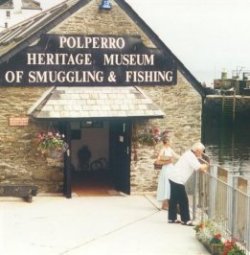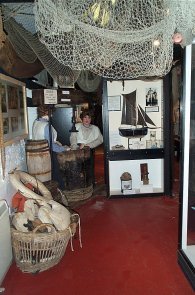
Polperro Harbour, PL13 2RB
Tel: (01503) 272423
Web: www.polperroharbourtrust.org/harbour-museum
History of Smuggling and Fishing
Situated in the old pilchard factory overlooking the harbour, the museum houses a remarkable collection of exhibits and 19th century photographs as well as many items of memorabilia dating from the 18th century when both smuggling and fishing thrived in Polperro. It tells the story of this Cornish fishing village's extraordinary history and some of the people who featured in it.
Robert Jeffrey
The Polperro youth press-ganged into the Navy aboard HMS 'Recruit' in 1807. The story of how be was cast ashore on a deserted island in the West Indies as punishment for stealing the captain's beer, and the political scandal that followed his rescue, is told in the museum.
Dr Jonathan Couch
Local Polperro doctor and eminent naturalist whose observations have contributed greatly to knowledge of marine life. Copies of some of his original drawings of fish landed in Polperro, used to illustrate his History of British Fishes (1862-1865) are on display.
Lewis Harding
Nephew of Sir Harry Trelawny of Trelawne, near Polperro, Lewis Harding (1806-1893) was encouraged to take up photography by Dr Jonathan Couch, the local Polperro doctor and eminent naturalist. Many of his photographs displayed were taken in the early 1860's, including that of Dr Couch supervising the landing of a thresher shark in the harbour.
Polperro Knitfrocks
The name given to tbe guernsey sweaters knitted in one of the traditional patterns used by Polperro families. The name 'guernsey' reflects the close links with the Channel Island. Distinctive patterns used by Polperro fisherman's wives can be seen in several of Lewis Harding's early portraits.

Polperro has depended on fishing for generations. In the 19th century, when pilchards were landed in large quantities, the fish were processed and packed in three factories near the harbour. The Heritage Museum now occupies one formerly owned by the Teglio family from Italy.
The fishing industry employed many men at sea and many more, with women and children, ashore in salting, pressing, cleaning and washing the fish. The pilchards were salted and cured before the oil was pressed from them using large screw presses and they were packed in barrels.
Large gaff-rigged boats known as Polperro gaffers were used for fishing. A model of the Lady Beatrice, one of the fastest gaffers owned by James Curtis can be seen in the Museum. Seine or drift nets were used to catch the pilchards. At one time there were some 40 drifters working out of Polperro harbour.
Contraband goods were smuggled across from Guernsey on a huge scale during the latter half of the 18th century, the Polperro boats often risking seizure by Revenue vessels patrolling the Channel looking for shipwrecks and checking for smugglers.
Of the many Polperro vessels involved in smuggling at the end of the 18th century, the 'Lottery' was the most infamous. The story of the Lottery's involvement in the murder of a Customs officer in 1798 which led to the trial and execution of one of her crew in 1801 is graphically told.
Another 'Lottery' crewman, Robert Mark, was later killed at sea by a shot from a Revenue vessel. His inscription can be seen in nearby Talland church where he lies buried, and his cutlass (inscribed and dated 1789) is also on display in the Museum.
When smuggling died out in the 19th century, Polperro attracted many distinguished artists and photographers, some of whose work is exhibited at the Museum.
Overlooking the harbour from the northern side.
Opening TimesDaily, March to October, 10.30am - 5.30pm Admission Charged |
Smuggling in Cornwall Talland
Looe Polperro Polperro Model Village Polruan Cornwall's History